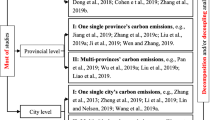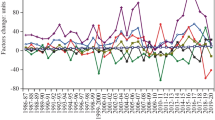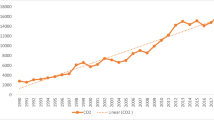Abstract
Low-carbon economic development is a strategy that is emerging in response to global climate change. Being the third-largest energy base in the world, Central Asia should adopt rational and efficient energy utilization to achieve the sustainable economic development. In this study, the logarithmic mean Divisia index (LMDI) decomposition method was used to explore the influence factors of CO2 emissions in Central Asia (including Kazakhstan, Uzbekistan, Kyrgyzstan, Tajikistan and Turkmenistan) during the period 1992–2014. Moreover, decoupling elasticity and decoupling index based on the LMDI decomposition results were employed to explore the relationship between economic growth and CO2 emissions during the study period. Our results show that the total CO2 emissions decreased during the period 1992–1998, influenced by the collapse of the Soviet Union in 1991 and the subsequent financial crisis. After 1998, the total CO2 emissions started to increase slowly along with the economic growth after the market economic reform. Energy-related CO2 emissions increased in Central Asia, mainly driven by economic activity effect and population effect, while energy intensity effect and energy carbon structure effect were the primary factors inhibiting CO2 emissions. The contribution percentages of these four factors (economic activity effect, population effect, energy intensity effect and energy carbon structure effect) to the total CO2 emissions were 11.80%, 39.08%, −14.82% and −4.32%, respectively, during the study period. Kazakhstan, Uzbekistan and Turkmenistan released great quantities of CO2 with the annual average emissions of 189.69×106, 45.55×106 and 115.38×106 t, respectively. In fact, their economic developments depended on high-carbon energies. The decoupling indices clarified the relationship between CO2 emissions and economic growth, highlighting the occurrence of a “weak decoupling” between these two variables in Central Asia. In conclusion, our results indicate that CO2 emissions are still not completely decoupled from economic growth in Central Asia. Based on these results, we suggest four key policy suggestions in this paper to help Central Asia to reduce CO2 emissions and build a resource-conserving and environment-friendly society.
Similar content being viewed by others
References
Ang B W, Zhang F Q. 2000. A survey of index decomposition analysis in energy and environmental studies. Energy, 25(12): 1149–1176.
Asane-Otoo E. 2016. Competition policies and environmental quality: Empirical analysis of the electricity sector in OECD countries. Energy Policy, 95: 212–223.
Cobanli O. 2014. Central Asian gas in Eurasian power game. Energy Policy, 68: 348–370.
Diakoulaki D, Mandaraka M. 2007. Decomposition analysis for assessing the progress in decoupling industrial growth from CO2 emissions in the EU manufacturing sector. Energy Economics, 29(4): 636–664.
Dong J F, Deng C, Wang X M, et al. 2016. Multilevel index decomposition of energy-related carbon emissions and their decoupling from Economic Growth in Northwest China. Energies, 9(9): 680.
Dorian J P. 2006. Central Asia: A major emerging energy player in the 21st century. Energy Policy, 34(5): 544–555.
Dorian J P, Franssen H T, Simbeck D R. 2006. Global challenges in energy. Energy Policy, 34(15): 1984–1991.
Feng J, Qi X, Feng X J, et al. 2011. Influencing factors of energy consumption for rail transport based on grey relational degree. Journal of Transportation Systems Engineering and Information Technology, 11(1): 142–146. (in Chinese)
Gao J, Wang J, Zhao J. 2012. Decoupling of transportation energy consumption from transportation industry growth in China. Procedia-Social and Behavioral Sciences, 43(4): 33–42.
Gonzalez P F. 2015. Exploring energy efficiency in several European countries. An attribution analysis of the Divisia structural change index. Applied Energy, 137: 364–374.
Hu B T, Fang C. 2014. An empirical research on economic growth and energy consumption of WanJiang City Belt: Based on tapio model and LMDI method. Journal of Tongling University, 2: 68–73. (in Chinese)
Hunt A. 1994. An explanation for the observed correlation between the decoupling index and the K-W-W stretching parameter. Journal of Non-Crystalline Solids, 168(3): 258–264.
Kaya Y. 1983. Transportation and energy in Japan. Energy, 8(1–2): 15–27.
Kaya Y. 1990. Impact of carbon dioxide emission control on GNP growth: interpretation of proposed scenarios. IPCC energy and industry subgroup, response strategies working group. Paris, France.
Lai B, Zheng H. 2017. Study on influencing factors of carbon emissions for industrial energy consumption in Dalian based on LMDI model. IOP Conference Series Earth and Environmental Science, 64(1): 012043.
Lioubimtseva E, Henebry G M. 2009. Climate and environmental change in arid Central Asia: Impacts, vulnerability, and adaptations. Journal of Arid Environments, 73(11): 963–977.
Liu A D, Zeng H X, Zhou Q. 2014. Empirical study of decoupling relationship between carbon emissions and export trade of China based on Tapio and LMDI. Forum on Science and Technology in China, 10: 85–91. (in Chinese)
Mannig B, Müller M, Starke E, et al. 2013. Dynamical downscaling of climate change in Central Asia. Global and Planetary Change, 110(Part A): 26–39.
Mao Z F. 2014. Cosmopolitanism and global risk: News framing of the asian financial crisis and the european debt crisis. International Journal of Communication, 8(1): 1029–1048.
Mercure J F, Salas P. 2012. An assessement of global energy resource economic potentials. Energy, 46(1): 322–336.
Mohsen C P, Hossein P, Shahriyar S H, et al. 2016. Decomposing influencing factors of energy consumption changes in the iranian industrial subsectors: The comparison of laspeyres and divisia methods. Quarterly Journal of Applied Theories of Economics, 2(4): 49–70.
Nepal R, Tisdell C, Jamasb T. 2017. Economic reforms and carbon dioxide emissions in European and Central Asian Transition Economies. Economics, Ecology and Environment Working Papers, 203: 1–29.
Organization for Economic Co-operation and Development (OECD). 2005. Decoupling: A conceptual overview. OECD Journal: General Papers, 5(11): 1–32.
Oh J, Yun C. 2014. Environmental Kuznets curve revisited with special reference to Eastern Europe and Central Asia. International Area Studies Review, 17(4): 359–374.
Olcott M B. 2006. The Shanghai Cooperation Organization Changing the “Playing Field” in Central Asia. Testimony before the Helsinki Commission. Helsinki, Finland.
Pablo-Romero M del P, Pozo-Barajas R, Yñiguez R. 2017. Global changes in residential energy consumption. Energy Policy, 101: 342–352.
Plyshevskii B. 2014. Reforming the economies of the CIS: Kyrgyzstan and Tajikistan. Problems of Economic Transition, 37(10): 24–42.
Rowland R H. 2001. Regional population change in Kazakhstan during the 1990s and the impact of nationality population patterns: results from the recent census of Kazakhstan. Post-Soviet Geography and Economics, 42(8): 571–614.
Ruziev K, Majidov T. 2013. Differing effects of the global financial crisis on the Central Asian Countries: Kazakhstan, the Kyrgyz republic and Uzbekistan. Europe-Asia Studies, 65(4): 682–716.
Siegfried T, Bernauer T, Guiennet R, et al. 2012. Will climate change exacerbate water stress in Central Asia? Climatic Change, 112(3–4): 881–899.
Sun J W. 1998. Changes in energy consumption and energy intensity: A complete decomposition model. Energy Economics, 20(1): 85–100.
Tang H, Chen D. 2015. Development features and temporal-spatial evolution of economy in Central Asia in the past 20 years. Journal of University of Chinese Academy of Sciences, 32(2): 214–220. (in Chinese)
Tapio P. 2005. Towards a theory of decoupling: degrees of decoupling in the EU and the case of road traffic in Finland between 1970 and 2001. Transport Policy, 12(2): 137–151.
Vehmas J, Luukkanen J, Kaivo-Oja J. 2007. Linking analyses and environmental Kuznets curves for aggregated material flows in the EU. Journal of Cleaner Production, 15(17): 1662–1673.
Wang Q, Zhou P, Zhou D. 2012. Efficiency measurement with carbon dioxide emissions: The case of China. Applied Energy, 90(1): 161–166.
Wang Q, Li R, Jiang R. 2016. Decoupling and decomposition analysis of carbon emissions from industry: A case study from China. Sustainability, 8(10): 1059.
Wang Q, Jiang X T, Li R. 2017. Comparative decoupling analysis of energy-related carbon emission from electric output of electricity sector in Shandong Province, China. Energy, 127: 78–88.
Wang W W, Zhang M, Zhou M. 2011. Using LMDI method to analyze transport sector CO2 emissions in China. Energy, 36(10): 5909–5915.
Yao H J, Zhou H F, Su F C. 2013. Water problems based on spatial matching patterns of water and land resources in Central Asia. Arid Zone Research, 30(3): 391–395. (in Chinese)
Yao L, Zhang H, Zhang C, et al. 2018. Driving effects of spatial differences of water consumption based on LMDI model construction and data description. Cluster Computing, 1–20. https://doi.org/10.1007/s10586-10018-12038-x.
Zhang Z X, Wang X S, Song X Q. 2011. The regional comparison study of Co-integration Relationship between China’s coal consumption and its economic growth. In: International Conference on Computer Distributed Control and Intelligent Environmental Monitoring. Changsha, China.
Acknowledgements
This work was supported by the Strategic Priority Research Program of the Chinese Academy of Sciences (XDA19030204) and the West Light Foundation of the Chinese Academy of Sciences (2015-XBQN-17). The authors are very grateful to the anonymous reviewers and editors for their critical review and comments which helped to improve and clarify the paper.
Author information
Authors and Affiliations
Corresponding author
Rights and permissions
About this article
Cite this article
Li, J., Chen, Y., Li, Z. et al. Low-carbon economic development in Central Asia based on LMDI decomposition and comparative decoupling analyses. J. Arid Land 11, 513–524 (2019). https://doi.org/10.1007/s40333-019-0063-0
Received:
Revised:
Accepted:
Published:
Issue Date:
DOI: https://doi.org/10.1007/s40333-019-0063-0




